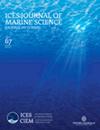爱琴海鱼类物种种内和种间竞争的定量分析
IF 3.4
2区 农林科学
Q1 FISHERIES
引用次数: 0
摘要
竞争决定了物种的共存和群落的组合,在维持生物多样性和生态系统恢复力方面发挥着核心作用。在这里,我们利用地中海国际拖网调查数据集提供的爱琴海南部底栖生物生物量,结合与营养生态学和产卵相关的六种特征数据,采用非对称竞争指数来量化一个物种对其他任何物种可能产生的竞争效应。我们模拟了选定的拖网水平协变量对竞争指数的影响,并指出了不同深度和生境之间的竞争差异。大多数物种之间的竞争强于物种内部的竞争。种间竞争的重要性高于预期(相比之下,种内竞争的重要性一般预期更高),而且存在广泛的多重竞争相互作用网络,这都与高生物多样性有关,同时也与群落中没有一个或少数几个物种占主导地位有关(与其他物种相比,没有物种的数量过多);后者可能与群落的稳定性和恢复力有关。对整个海洋生态系统的竞争进行量化,有助于预测鱼类群落将如何应对未来的资源供应和环境条件。本文章由计算机程序翻译,如有差异,请以英文原文为准。
Quantification of intraspecific and interspecific competition in fish species of the Aegean Sea
Competition shapes species coexistence and community assembly, playing a central role in maintaining biodiversity and ecosystem resilience. Here, we used an asymmetric competition index that quantifies the possible competitive effect of a species on any other, using southern Aegean Sea nekton biomass from the Mediterranean International Trawl Survey dataset, combined with data on six traits relevant to trophic ecology and spawning. We modeled the effect of selected haul-level covariates on the competition index, and we indicated competition variation across depth and habitats. Most species experienced stronger inter- than intra-specific competition. Both the higher-than-expected significance of interspecific competition (in comparison to intraspecific that is generally anticipated to be higher) and the existence of an extensive network of multiple competitive interactions indicated, are associated with high biodiversity, combined to the absence of dominance by one or a few species in the community (no species is disproportionally highly abundant in comparison to others); the latter may be relevant to community stability and resilience. The quantification of competition across marine ecosystems can help predict how fish communities will respond to future resource availability and environmental conditions.
求助全文
通过发布文献求助,成功后即可免费获取论文全文。
去求助
来源期刊

ICES Journal of Marine Science
农林科学-海洋学
CiteScore
6.60
自引率
12.10%
发文量
207
审稿时长
6-16 weeks
期刊介绍:
The ICES Journal of Marine Science publishes original articles, opinion essays (“Food for Thought”), visions for the future (“Quo Vadimus”), and critical reviews that contribute to our scientific understanding of marine systems and the impact of human activities on them. The Journal also serves as a foundation for scientific advice across the broad spectrum of management and conservation issues related to the marine environment. Oceanography (e.g. productivity-determining processes), marine habitats, living resources, and related topics constitute the key elements of papers considered for publication. This includes economic, social, and public administration studies to the extent that they are directly related to management of the seas and are of general interest to marine scientists. Integrated studies that bridge gaps between traditional disciplines are particularly welcome.
 求助内容:
求助内容: 应助结果提醒方式:
应助结果提醒方式:


